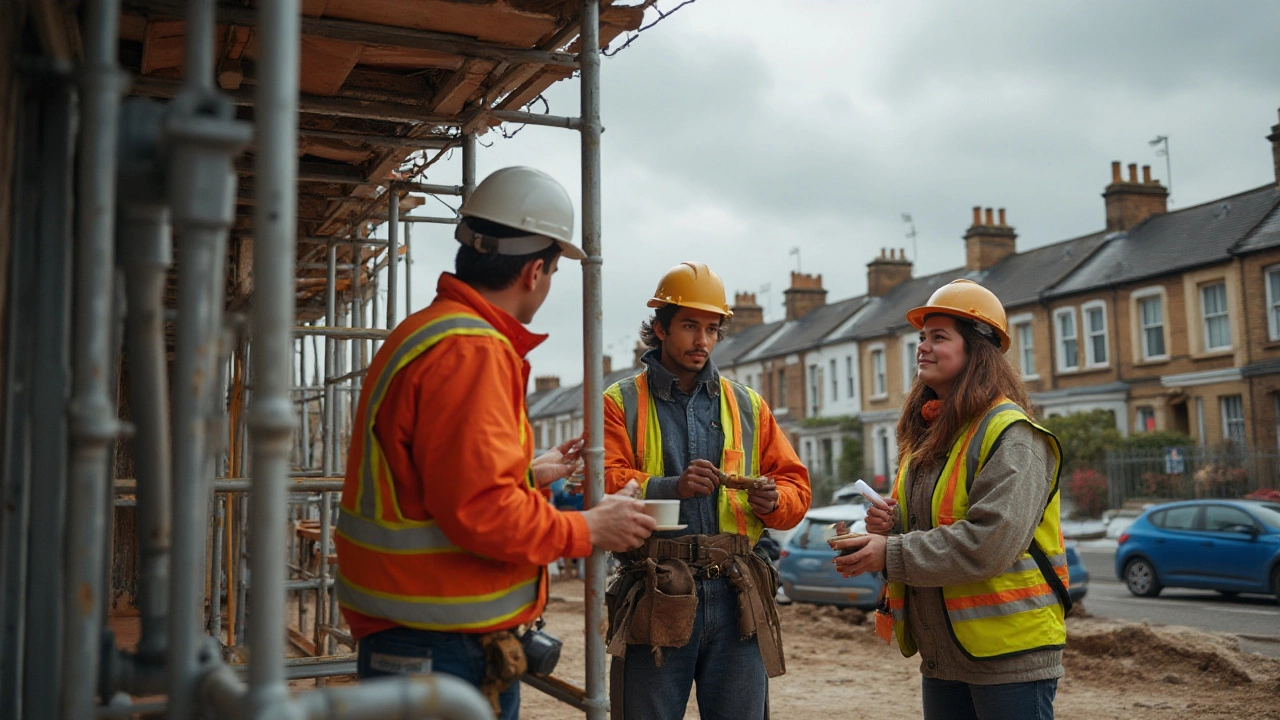Embarking on a home remodel can be as exciting as it is daunting. Whether you're dreaming of a modern kitchen or revamping your entire living space, understanding the order in which to tackle these tasks is crucial. Picking the right sequence doesn't just keep things flowing smoothly; it can also help prevent costly mistakes and ensure your project is completed efficiently.
The remodeling process can be likened to putting together a puzzle — every piece fits in a particular order to complete the big picture. Without laying down a structural plan, even the most creative visions can fall short. The correct strategy allows you to address the essentials, laying a solid foundation for the decorative details that follow.
Getting each stage right not only aligns with practicality but also supports a more relaxing transition from chaos to comfort. Let's take a detailed journey through the fundamental phases of home renovation, where every step sets the stage for the next and each decision builds towards the home of your dreams.
- Planning and Design
- Demolition and Structural Alterations
- Systems and Infrastructure
- Walls, Flooring, and Fixtures
- Finishing Touches and Final Inspection
Planning and Design
Embarking on a home remodeling journey begins with one of the most crucial phases — planning and design. This stage isn't just about envisioning your new space; it's about laying down a roadmap that will guide you through the complex process of renovation. A successful remodel is born from a well-thought-out plan that considers both functionality and aesthetics. Begin by identifying your primary goals. Are you increasing the space available, modernizing outdated areas, or enhancing the property's value? Enlisting an architect or a designer can be invaluable during this phase. They bring expertise and a fresh perspective to your vision, which ensures the plan is both practical and exciting. It's also wise to create a timeline to keep the project manageable and realistic. Each task is assigned a deadline, which helps in tracking progress and avoiding prolonged disruptions.
A crucial element of this phase is budgeting. It’s easy to get carried away with ideas, but grounding your plans in a realistic budget is paramount. Expect the unexpected by factoring in a contingency of around 10-20% of your total estimated costs. This financial cushion can absorb any surprises that may arise during construction. One might say that planning for a remodel is like drafting a novel: every page, every word counts. For instance, according to Remodeling Magazine's Cost vs. Value Report, kitchen remodels often recoup about 54% of their project cost in added home value. This data supports allocating a larger portion of your budget to areas with higher returns on investment.
The excitement often lies in the design details—selecting color schemes, materials, and layouts. Consider how these elements work in harmony within the existing structure. Choose designs that resonate with your personal style but also fit comfortably within your neighborhood’s aesthetic. Keep sustainability in mind as well. Opting for energy-efficient appliances or eco-friendly materials not only reduces long-term operational costs but also contributes to environmental conservation. Converting ideas into actionable designs often involves visualizing the transformation before it begins. Software tools can help create virtual models of your space, allowing you to experiment with different layouts and designs before settling on the final plan. These tools provide flexibility and foresight, reducing risks associated with last-minute changes.
“Good buildings come from good people and all problems are solved by good design.” – Stephen Gardiner
Collaboration with your spouse or family members during this stage is vital. Their input not only enriches the plan with diverse ideas but also ensures everyone's needs and preferences are catered to, which is essential in shared spaces such as kitchens and living rooms. Incorporating their feedback can also prevent future disputes once the remodel is underway. Finally, being aware of local regulations and obtaining necessary permits is an integral part of this phase. Failure to comply with local building codes can result in fines and project delays. Research thoroughly and communicate with local agencies to understand the requirements specific to your location. This administrative aspect might seem tedious but is essential for smooth sailing throughout the remodel's life.
Demolition and Structural Alterations
The demolition phase sets the stage for any substantial home remodeling project. It's much more than just hammer-swinging and dust clouds—it's about precise planning and careful execution. This crucial step is your opportunity to clear space, remove outdated or damaged elements, and prepare the groundwork for your vision to come to life. Engaging experienced professionals is vital; they bring the expertise needed to navigate tricky situations, like removing load-bearing walls or dealing with hazardous materials such as asbestos, commonly found in older structures. As daunting as it might seem, demolition done right heralds a fresh start, laying down the blank canvas for your creative masterpiece.
When contemplating structural alterations, it's essential to consider the impact on your home's integrity and safety. Changes such as removing walls to create an open floor plan, adding extensions, or altering rooflines require meticulous planning and a deep understanding of your home's architecture. It's here that the collaboration between engineers, architects, and contractors becomes invaluable. Professionals can provide insight into potential challenges and suggest innovative solutions that balance aesthetic desires with structural soundness. The success of this stage often relies on detailed blueprints and a keen attention to regulatory building codes, ensuring your remodel is both beautiful and lawful.
"The secret of getting ahead is getting started," said Mark Twain. In demolition and structural alterations, knowing when to leap forward and when to pull back is key.A well-timed and efficiently executed demolition mitigates the risks of costly errors and delays, allowing subsequent construction phases to proceed without setbacks. The key is to work sequentially: only once old structures are safely removed, can new frameworks be erected. Experts emphasize the necessity of choosing the right time for demolition, avoiding seasons with adverse weather conditions that could complicate or stall work. Proper disposal of debris plays an integral role in keeping the site organized and minimizing environmental impact, often requiring adherence to local disposal regulations.
Demolition can uncover surprises, from hidden damages to undocumented pipes or wires. While such discoveries might seem like setbacks, they present opportunities to address these issues before new construction begins. With challenges come opportunities to rethink plans, enhance the layout, or incorporate modern systems that were previously impossible. During this phase, leveraging the latest technology in building materials can offer significant long-term savings and improve the eco-friendliness of your home. As with every stage of the home remodeling process, collaboration and open communication with your team keep the project aligned with your vision, budget, and timeline.
Home remodeling, particularly when it involves structural changes, is not just about aesthetic transformation—it’s about optimizing the space to fit your lifestyle. For instance, converting a cramped kitchen into a spacious culinary haven or transforming a disjointed living area into an open, connected space, requires thoughtful planning. Knowing what supports or elements are essential and which can be removed without compromising safety is critical. By approaching demolition with a clear strategy and professional support, you establish a strong foundation, one capable of carrying the weight of hope and anticipation that come with every home improvement project.

Systems and Infrastructure
When planning a home remodeling project, handling the systems and infrastructure can be pivotal to the success of the entire venture. This stage encompasses the unseen yet crucial elements that hold the household together — plumbing, electrical configurations, HVAC systems, and more. Like the nervous system in the body, these components operate quietly but are vital for functioning. Upgrading or modernizing these systems can be a hefty job but is best done before walls and furnishings are put in place. By addressing these aspects early, you ensure sustainability and efficiency in the long run.
Let’s paint a picture of the significance of this process. Suppose you're looking to install a contemporary HVAC system to optimize energy use. Retrofitting the necessary ductwork demands foresight and precision engineering. Without attending to this at the appropriate moment, not only do you risk disrupting freshly painted walls and new flooring, but you might also face inflated costs and scheduling setbacks. An American study reported by the Department of Energy notes that upgrading to efficient systems can lead to a reduction in energy bills by as much as 20%. The numbers speak volumes about the tangible benefits of getting these foundations right.
Plumbing and Electrical Systems
The plumbing and electrical systems are like the veins and arteries of your house. They network quietly behind walls and beneath floors, ensuring water flows, and electricity powers your lifestyle. It's essential to assess the current status and future demands of these systems. Think about increased kitchen usage, additional bathrooms, or even outdoor lighting endeavors. Installing these setups early not only safeguards against leaks and shorts but allows you the creative freedom to pursue design without confinement.
Consider the plight of complex plumbing reroutes or electrical panel updates. Undertaking these tasks early allows you to make changes with minimal obstruction to more polished phases of remodeling. For example, upgrading to tankless water heaters or installing smart home electrical systems infuses modernity while boosting home value. Experts like Bob Vila often recommend preemptively upgrading these infrastructures to accommodate home tech trends swiftly.
Heating, Ventilation, and Air Conditioning (HVAC)
Implementing efficient HVAC systems during a renovation might not immediately transform the aesthetics of your living space, but it dramatically impacts comfort and cost. A well-designed system regulates climate control, reducing energy waste. It enhances indoor air quality, which is crucial when spending most of your time indoors. Investing in zoned heating and cooling systems empowers precise temperature adjustments per room, promoting energy conservation and personalized comfort.
As energy-conscious designs become the norm, opt for state-of-the-art, programmable thermostats and high-efficiency models. A strong HVAC system not only prepares homeowners for seasonal flux but, as a bonus, speaks to the market's preference for eco-friendly choices. As the Environmental Protection Agency expresses, these preferences can contribute significantly to a home's resale attractiveness.
Strategically navigating the systems and infrastructure during home remodeling ensures that your abode not only stands the test of time but anticipates future needs. This forward-thinking aspect bridges the present with an envisioned future, making the transformation not just about change but smart planning and execution.
Walls, Flooring, and Fixtures
As you step into phase three of home remodeling, the focus shifts to installing walls, laying down flooring, and adding fixtures. This stage brings structure to bare bones, infusing personality and style into the space. Choosing materials can be a thrilling adventure in itself, having a significant impact on both the aesthetic and functional qualities of your home.
Material Choices and Considerations
When it comes to walls, options abound. Whether you prefer the timeless elegance of plaster or the more contemporary appeal of drywall, each material brings its own charm and requirements. Drywall is often favored for its cost-effectiveness, ease of installation, and versatility with paint and wallpaper. Plaster, though more labor-intensive, can add character with its textures and durability. Deciding on the right material involves considering factors such as humidity, wear, and how often you'll change the room's look. Similarly, flooring decisions carry substantial weight. From the classic warmth of hardwood to the sleek modernity of polished concrete, the choice speaks volumes about your taste and lifestyle. Tiles offer a world of patterns and colors, making them a wonderful choice for creative spaces.
Installation Process
Installation is a meticulous craft that demands precision and planning. Start with the walls, ensuring they are structurally sound and properly aligned before applying the chosen finish. This is a critical stage where mistakes can lead to long-term issues. Once the walls create a blank canvas, flooring comes next. Installation experts often recommend working from the room's center outwards to ensure uniformity of pattern and alignment. Securing the flooring well helps in avoiding creaks and gaps, maintaining the integrity of the home over time.
Integrating Fixtures
Fixtures are the jewels of the renovation process, offering the first real glimpse of the home's specific style. They range from essential elements like door handles and cabinet knobs to striking light fixtures and decorative hardware. Each choice should harmonize with the flooring and wall finishes, creating a cohesive design. The right fixtures can elevate a simple room into luxury, making every piece an investment in ambiance. Remember, these elements reflect your personal taste and often remain in place for years, making their selection worthy of careful consideration.
"The details are not the details. They make the design." – Charles Eames
This is precisely why special attention to fixtures cannot be understated. Their role goes beyond utility; they breathe life into the structure you've built from the ground up.

Finishing Touches and Final Inspection
As the dust settles and the scaffolding finally comes down, the excitement of bringing your home improvement project to life escalates. This stage, often considered the most rewarding, is about infusing your personality into the renovation with carefully selected decor and thoughtful details. The finishing touches can dramatically influence not only the aesthetic appeal but also the functionality of your remodeled space. From selecting the perfect paint colors and striking light fixtures to installing elegant hardware on cabinets, every decision resonates the home’s renewed character. It's a time where your vision becomes tangible, and the space begins to tell your story.
With the big tasks out of the way, the detailed work now takes precedence. Interior painting, fixture installations, and final designs like backsplash in kitchens or unique tiling in bathrooms demand attention. Make sure to choose finishes that complement the primary design theme yet offer a sense of individuality — perhaps a dramatic feature wall or a statement piece of furniture. It's also practical to invest in energy-efficient appliances if they weren’t initially included in your renovation, as they add value and reduce ongoing costs.
The importance of a thorough final inspection cannot be overemphasized. This step ensures that everything meets the original plan and intent and adheres to all safety and building standards. Walking through each section of the revamped space with a hawkish eye is crucial to spot inconsistencies or unfinished details often overlooked amidst excitement. Check functionalities like plumbing, electrical outlets, and any technological enhancements installed during the process. "Inspecting your renovation carefully is as important as laying the first brick," says renowned architect Jeffrey Strauss. This phase is your opportunity to guarantee the work matches the quality expected and contracted.
To help corral the myriad elements requiring attention, create an exhaustive checklist. Here’s a useful outline:
- Ensure paints and surface treatments are even and without blemish.
- Test all installed appliances for proper functionality.
- Verify that cabinets and built-ins are aligned and securely anchored.
- Inspect grouting and sealants for consistent application and finishing.
- Check that lighting fixtures and outlets are operational and safe.
- Make sure any punch-list items from contractors are addressed and resolved.
Notably, this phase is when the initial investment truly showcases its merit. With careful attention to these details, your remodel shouldn’t only reflect aesthetic splendor but functional harmony too. While this part of the process may demand patience and a meticulous nature, remember that it culminates in the gratifying conclusion of your home remodeling adventure. Take a moment to stand back, admire your accomplishment, and breathe in the renewed atmosphere your hard work has captured.

Author
Damon Blackwood
I'm a seasoned consultant in the services industry, focusing primarily on project management and operational efficiency. I have a passion for writing about construction trends, exploring innovative techniques, and the impact of technology on traditional building practices. My work involves collaborating with construction firms to optimize their operations, ensuring they meet the industry's evolving demands. Through my writing, I aim to educate and inspire professionals in the construction field, sharing valuable insights and practical advice to enhance their projects.